Light years ahead
The on-court legacy of the Warriors is everywhere with these four NBA conference finalists.



The 2020 Bubble Playoffs aren’t done, but there’s been one clear winner of the whole charade: the Golden State Warriors. More specifically, the long-lasting on-court legacy of the Light Years Era.
In the six-year span between Stephen Curry’s Madison Square Garden breakout in 2013 and the devastating injuries Kevin Durant and Klay Thompson suffered in last year’s Finals, the Warriors warped the game at light speed. Other past champions shot threes, but none made the three-point line the most dangerous pivot point in their attack. They played outside-in rather than inside-out, leveraging the threat of threes to get to the hoop, not the other way around. Remember when the Cavaliers willingly surrendered uncontested dunks in the 2017 Finals instead of letting them shoot threes? How wild was that?

In those six years, the Warriors accelerated massive changes to the game that previously took decades to stick. They were outsiders who upended mainstream ethos, then influencers who seemed like modern-day prophets. Before we knew it, they became the very definition of the establishment they once disrupted. Wanna know one of my favorite stats of all time? The Warriors — the team who cemented the mainstream acceptance of the “3s or layups” mantra — were second to the Spurs in points generated from mid-range in the 2018-19 season. That’s how quickly heresy became orthodoxy.
Something interesting happened last round that should further vindicate the Light Years Warriors’ ethos. With the possible exception of Boston vs. Toronto, the teams who moved without the ball beat the ones who spaced out for their stars.
The Lakers pounded the Rockets inside while devising a defensive scheme that erased Houston’s stars and floor spacers.
The Heat spun a well-drilled Bucks team into a frenzy on both ends, stretching their paint-heavy defense and flummoxing their battering ram superstar.
The Nuggets zipped cutters off the best passing big man in NBA history and nudged a Clippers team with the most talented roster in the league into self-destruct mode.
The teams that ranked first (Heat), second (Nuggets), and fourth (Lakers) in possessions ended with cuts in the regular season toppled the ones that finished 17th, 27th, and 24th, respectively. Two of the outcomes were upsets, and the third was less competitive than expected. A few weeks ago, Stan Van Gundy, the terrific coach turned terrific TNT analyst, told friend of the program Mo Dakhil that cutting “has really sort of died in the NBA.” The ensuing month emphatically proved otherwise. Really good teams really can die via a thousand cuts.
(I’m not ready to call the Eastern Conference Finals, but the Heat’s series lead over a Celtics team that finished middle of the pack in that cutting metric during the season is another significant data point in this trend).
Because of that, the Warriors should feel vindicated. As the game shifted to the perimeter, teams applied the threat of shooting in two distinct ways. Some, like the LeBron-era Heat (and second-stint Cavaliers) or the 2018 Rockets, spread out to give their ball-dominant stars cleaner driving lanes. Others, like the Warriors, put teams through the ringer with constant player movement across a wider surface area of the court. They took the same ideology — three-pointers are good and dangerous and really hard to defend! — and applied it in completely different ways. This is the story of the last 15 years of the sport.
So in a way, this year’s second round was really a battle between two warring sects of basketball modernity. It was Heliocentricism vs. Strength in Numbers. And one interpretation clearly won: the Warriors’.
There’s a piece of the Warriors in every conference Finalist
None of the four remaining teams offers everything the Warriors did at their peak, but each has built a team around one of the core pillars of their ground-breaking offensive success.
The Nuggets built an inverted system around the modern version of Stephen Curry.
Ethan Strauss was spot on when he recently compared these Nuggets to the pre-Steve Kerr Warriors. While I’m not sure that Denver is on its way to duplicating Golden State’s title success, I very much agree with Ethan’s Stephen Curry-Nikola Jokic comparison.
Both players have been underestimated on the basis of appearance and both players boast a unique, dominating skill. For Curry, it’s shooting, on ball and off. For Jokic, it’s passing, from the perimeter and from the post. The perimeter passing is what sets Jokic apart and completely inverts the game. Just as defenses were not initially set up for guarding what Curry could do out of the pick-and-roll (during the 2013 playoff run, Curry completely broke years of established pick-and-roll coverage rules), defenses are also not constructed to deal with a 7-footer who passes like a more creative Jason Kidd.
Just as Curry’s shooting and movement put a fresh coat of paint on Mark Jackson’s rudimentary offensive principles, Jokic’s inversion allows the Nuggets to make a basic offense look complex. (And with Jamal Murray breaking out like this, it’s possible the Nuggets actually have two Stephs on the roster! But let’s set that comparison aside for now).
Step 1 of the Warriors’ ground-breaking philosophy was exceedingly simple: Bigs out high, wings down low, and Curry dancing all over the court to connect the dots. The system didn’t have many entry points, which of course only took the Warriors so far and was one reason (among many) that Jackson got fired.
But as a starter kit, it worked because Curry could flow into so many different types of plays from the same basic setup. He could start at the top of the key, on the wing, in the corner, or right underneath the basket running crazy 8s with Klay Thompson.
Curry’s offensive versatility and unique movement patterns gave the other four Warriors a fulcrum to play specific, rigid roles as effectively as possible. Curry gave David Lee a pick-and-roll setup man, Andrew Bogut a high-post partner, Harrison Barnes and Andre Igoudala a shot creator for corner triples, and Thompson an extra screener to nudge into catch-and-shoot chances. Curry was the system’s quarterback and everyone else was a receiver, even though Curry himself wasn’t hogging the ball.
There really aren’t many entry points to Denver’s offense. Most of it flows off the simplest action in the book: a two-man game between the center (Jokic) and the point guard (Jamal Murray). Jokic is No. 1 in the league in touches per game in the playoffs, while Murray is No. 4. They get the ball nearly 195 different times a game and together account for nearly half (48.5 percent) of Denver’s total touches. As a point of comparison, the LeBron James-Anthony Davis duo touches the ball just under 156 times and accounts for 35 percent of LA’s total touches. Who’s the two-man team again?
Like Young Curry with his movement, Jokic (and increasingly Murray, but again let’s set him aside for now) simultaneously gobbles up most of the offense and empowers his teammates with his passing and versatility. They move all over the court without the ball because they know he’ll find them if they’re even slightly open.
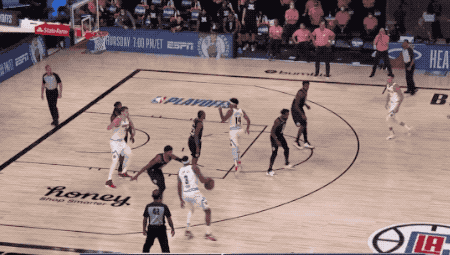
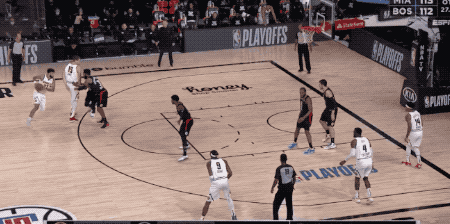
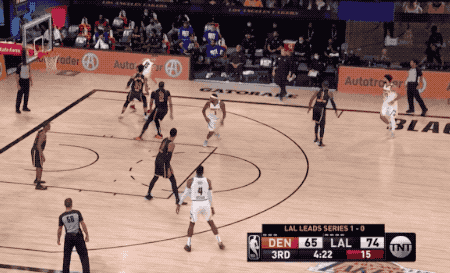
It sounds simple to avoid double-teaming Jokic and make him score in one-on-one situations. But just as Curry once slid around and through a maze of screens to start plays a half step ahead of rushing defenders, Jokic catches the ball from too many angles for a defense to program its response. The Clippers rotated to Jokic differently in these two plays, but he slipped the screen so quickly that neither one mattered. He got the right pass off regardless.
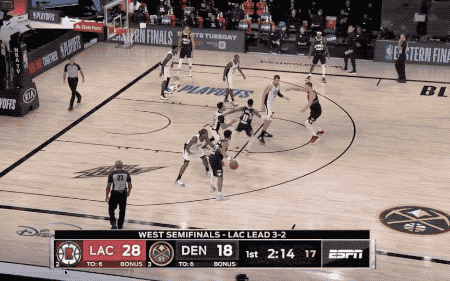
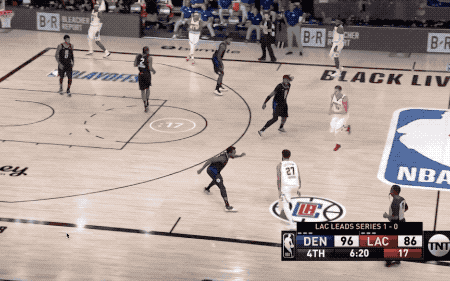
When combined with Murray’s creative shot-making, Jokic allows the Nuggets to generate infinite combinations from the same two elements. There’s a reason I used the phrase “two-man game” to describe what others would call a Jokic-Murray pick-and-roll. Is it really a pick-and-roll when either player can function as the ball-handler, screener, passer, shooter off the catch, shooter off the dribble, popper, hand-offer, half-roller, slipper, play advancer, play retreater, and so on? “Pick-and-roll” only describes one potential form that partnership takes.
Jokic (and Murray) thus make planned double teams look like single coverage, and vice versa. All the other Nuggets have to do is cut the instant their man even briefly turns their attention to Jokic, and he’ll make sense of the rest. To a layperson, Denver’s motion looks chaotic. To Jokic, one cut is simply setting up another, which then sets up the open shooter. These are two separate plays from two different camera angels that are actually one in the same to Jokic.
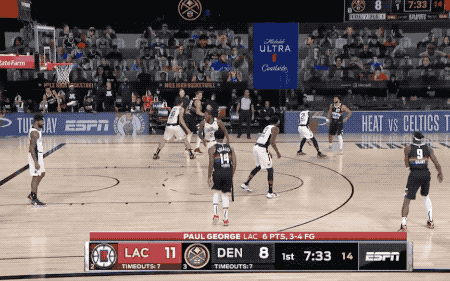
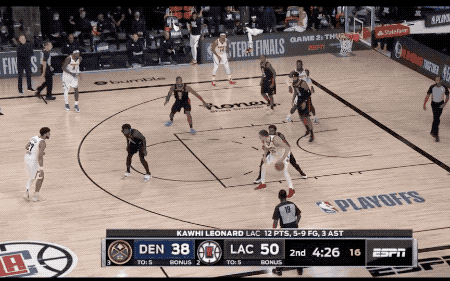
Providing order within chaos was the genesis of Steph’s rise, much as it has been Jokic’s. The next step for the Warriors was to maintain that dynamic while adding more entry points. The way they did it mirrors the way one team has built its entire offensive system.
Death by split cut: How Bam Adebayo allows the Heat to break opponents with off-ball movement.
Draymond Green wasn’t supposed to revolutionize the big man position. He wasn’t even supposed to start until David Lee strained his hamstring in the Warriors’ final 2014 preseason game. “I knew Draymond was a jack of all trades. I was worried that he was going to be a master of none,” Steve Kerr told SB Nation’s Paul Flannery.
Instead, Green’s emergence gave the Warriors’ offense that additional entry point to amp up the chaos. His passing out of the post popularized the phrase “split cut” — best described as two players coming together for a beat on the wing and then darting in different directions. His screening, dribble-handoff game, and quick decision-making allowed Golden State’s offense to flow from one sequence to another before the defense could reset. He took the pre-Kerr Warriors’ basic theory of inversion, eliminated the pauses between actions, and thus gave each Warrior a half step of a head start on each sequence.
His legacy now lives on in Bam Adebayo, who does all of those things and more for a Miami Heat offense that runs even the most disciplined opponents ragged. The split cut is alive and well in South Beach.
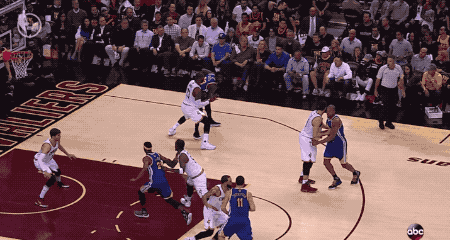
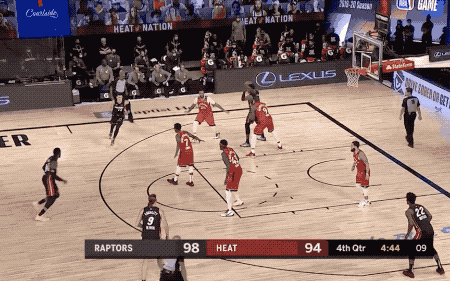
Bam’s dribble handoff game with each perimeter player — most notably Duncan Robinson, but not just with him — moves so quickly that there’s no time for a third player to get into position to stop his dives to the hoop. The Celtics and Bucks are among the game’s best at collectively packing the paint. Yet they’ve been gashed by a Goran Dragic/Bam pick-and-roll that flies through their line of sight before their backside defenders know what hit them.
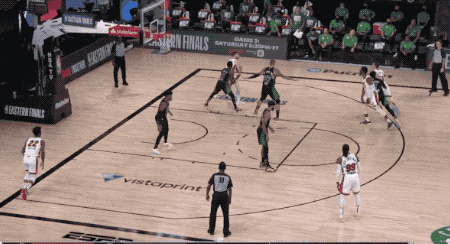

As with those pre-Durant Warriors, these Heat seem to fare best against disciplined opponents. They’re scoring 113 points per 100 possessions this postseason despite playing against the No. 1, No. 4, and No. 6 defenses from the regular season. That’s because they force these great units to abandon their principles and chase ghosts, sewing chaos within their orderly structures.
That doesn’t happen without Bam Adebayo. While Miami appears to be sprinting like hell on offense, they were actually just 16th in average offensive speed during the regular season, though they are up to fifth in the playoffs. The real key is that the Heat don’t stop moving during that brief window when one move breaks down and another other begins. They carry over the slight advantage they gained from one sequence into the next, in large part because they can recycle ball possession through Adebayo while everyone else keeps cutting. It’s as if they’re running a relay race with Adebayo exchanging each baton.
That’s why the Celtics can’t get a handle on Tyler Herro in this series. Herro is a capable pick-and-roll player from a standstill position, especially for a rookie. But he’s a much more devastating pick-and-roll player when he catches the ball with a half-step advantage on his man. He’s better on the move than stationary, more elusive than explosive, more of a pull-up shooter than a vertical leaper. Just as Klay Thompson found a way to stay in motion when teams took away his jumper, so too does Herro.
Thanks to Adebayo, motion is exactly what Herro gets. Like Draymond before him, Adebayo nudges Herro forward with rapid decision-making on his screens, slips, and dribble handoffs. To use the relay race analogy again, it doesn’t matter what coverage the Celtics should be using in theory to contain Herro if they’re still passing off the baton.
Friend of the program Nekias Duncan highlighted this play from the fourth quarter of Game 4 as an example of Boston foolishly giving Herro too much room to rise up on a dribble handoff.
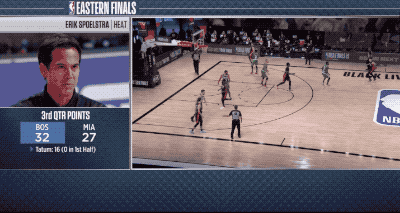
But the Celtics didn’t fail because of poor strategy. They failed because the Heat were way ahead in the possession’s relay race. While Adebayo, Herro, and Robinson transitioned seamlessly between the play’s stages, Daniel Theis and Brad Wanamaker were still passing off the baton. That hesitation was their undoing.

And though I question the strategy of trapping Jimmy Butler way beyond the three-point line with under two minutes left, that breakdown also looked worse because Adebayo made himself an outlet far sooner than the Celtics anticipated. Notice how Adebayo’s quick slip freezes both Hayward and Brown, simultaneously neutering the impact of the trap and the timing of the crucial next rotation.
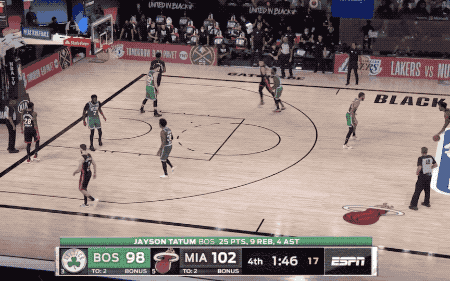
That’s game over for the Celtics regardless of their scheme. Bam passed off the baton before the Celtics even reached the checkpoint to make their exchange. It looked very familiar.
All that said, there’s another pillar of the Warriors’ system that was passed down to Miami’s opponent.
The Celtics and the relocation three
Kerr was (is?) famously skeptical of pick-and-rolls because he felt it turned the other three players into statues. The high post split cuts and dizzying array of random off-ball screens were more in line with the Strength in Numbers ethos.
But Kerr’s also no dummy. He knew he possessed the ultimate double whammy: the league’s most dangerous pick-and-roll ball-handler in Curry and a collection of shooters and screeners that could spread help defenders thin. When push came to shove, Kerr deployed the famous Death Lineup and put the ball in Curry’s hands.
But running the league’s most conventional play in the most conventional way wasn’t the Warriors’ best path to success. They needed to mix in the unpredictable and constant off-ball motion that kept them one step ahead of the defense’s schemes. They needed to make their ball screens flow, not stop.
The way they did it lives on in a Celtics team that has threaded one of the most challenging needles in the sport, at least until the East Finals. How do you get a team stacked with perimeter shot creators to enhance each other instead of getting in the way? Or put another way: how do you avoid basketball’s zero-sum problem of diminishing returns.
It’s so easy for teams with so many one-on-one scorers like the Celtics to stagnate and struggle to define a proper pecking order. Just ask … the 2018-19 Celtics! But Boston made it work this season due to one key concept the Warriors introduced: the relocation three. Or as my old colleague Kristian Winfield called it: the “Peek-A-Boo play.”

Curry and the Warriors separated themselves from the pack because they kept moving after they gave up the ball on pick-and-rolls. Curry’s next move was to dart to open space beyond the line to get the ball back before the distracted defense knew what hit them. Best-case scenario, he/they got an open three on a give-and-go.

Next-best scenario, that extra movement tilted a defense before swinging it around into a more open drive or shot. Keep an eye on Steph and Klay throughout this sequence. The very threat of Steph looping around to get the ball back at the top of the key sets up the crucial backdoor cut. Meanwhile, Trevor Ariza has his back to the play because Klay kept running the other way.
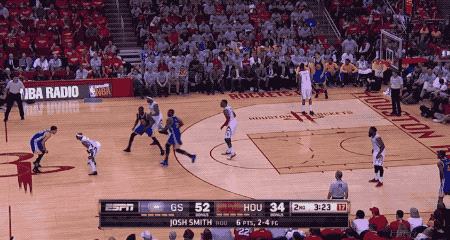
That’s exactly how the Celtics use their collection of perimeter shot-makers to break the best defenses. With Steph injured, Kemba Walker has become the new king of relocation threes.
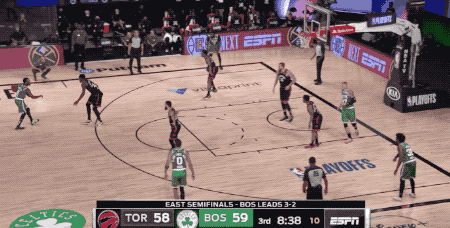

But he’s not the only elite relocator on the roster. Jayson Tatum creates the small openings he needs by sliding along the line on the opposite side.
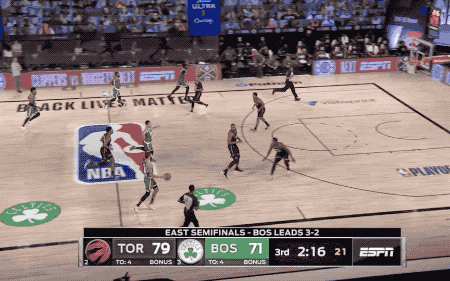
And Jaylen Brown finds many of his driving lanes by tip-toeing into open spaces when the rest of the defense is loading up to the ball.
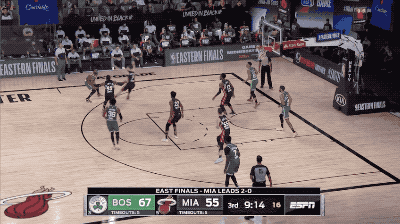
Even Marcus Smart, whose offensive skill set defies explanation, puts himself in position to catch and attack by slightly shifting his positionin on the opposite side of someone else’s pick-and-roll. You would think that the key to stopping Boston’s scorers is to have Smart’s man ignore him to double team and/or muck up the paint. That was certainly the Raptors’ strategy whenever Boston put one of their big men in a pick-and-roll. They had Pascal Siakam, their most hyperactive and dangerous help defender, “guard” Smart early in the series.
But Smart broke that coverage because he kept cutting ever so slightly into open passing lanes. He hit shots, yes, but he also put himself in quality positions by side-stepping along the three-point line at the very second Siakam turned his head to focus on the ball. His relocation efforts did just enough to tilt Toronto’s defense.
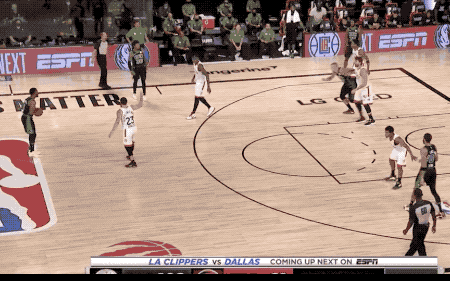
Eventually, they were so successful as a distraction tactic that they froze the backside defense just enough to expose those slower Toronto bigs in pick-and-roll.
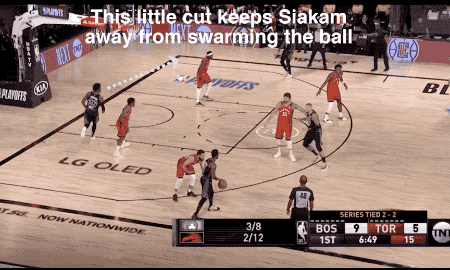
So yes, Boston is a pick-and-roll team that doesn’t get as much of its offense directly off cuts as the other three conference finalists. But they’ve applied the Warriors’ relocation strategy to juice up a play that so often turns the other three players into statues. The Celtics don’t cut to score, necessarily. They cut to create easier spot-ups or drives.
What about the Lakers, then? They’re star-driven, hierarchical, and built on two guys playing bully ball. Isn’t that the antithesis of the Warriors?
To the early Warriors, yes. But unlike LeBron James’ Cleveland teams, who grew more out of the “star and space” strand of the modern game, these Lakers move a ton off the ball and dominate in transition. Those are Warriors tentpoles, especially once Kevin Durant came aboard and their offense became more star-centric.
Early on, KD blended his game into the whirling Warriors dervish. But as he gained more influence and the complementary players started to age, Golden State’s movement began to serve his individual scoring ability rather than the other way around. It didn’t always look as smooth as in the past and there were clear signs of tension, but the Warriors had to evolve to beat the off-ball switching opponents employed to minimize their movement.
Increasingly, the Warriors moved and screened at unconventional angles to maintain Durant’s matchup advantage. They used their usual movement to distract the help so KD could go one-on-one. Moving around allowed other players on the roster to be useful as decoys even as their offensive skills dwindled.


The Lakers enter every series with a massive talent advantage at the top of the roster and a significant deficiency everywhere else. How do you enhance the former and mask the latter? How do you run 90 percent of your offense through two players without becoming too predictable? You do what the Warriors did with Durant and move the other three players around to divert attention away from LeBron and Anthony Davis.
If that motion results in an open scoring opportunity via a cut or an open spot-up, the stars are more than willing to give the ball up.

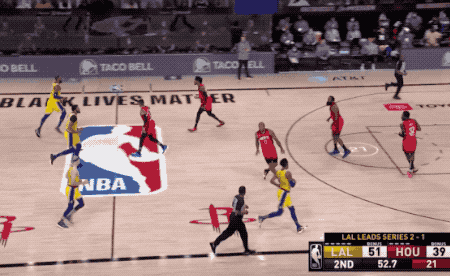
But if not, that traffic at least keeps extra bodies off James and Davis, making life even more difficult for their primary defenders. The Lakers, like the Warriors near the end of their run, lack supplementary players with enough shooting gravity on their own to scare anyone. Teams happily let the 2018 version of Andre Iguodala or Kevon Looney stand still to send more bodies to Durant. They’re even more willing, in theory, to leave Kyle Kuzma, Rajon Rondo, Alex Caruso, and Kentavious Caldwell-Pope open to double-team James and Davis.
But those players don’t stand still. They cut to force their defender to at least honor them, and that takes their attention away from the more dangerous threat the two stars provide.
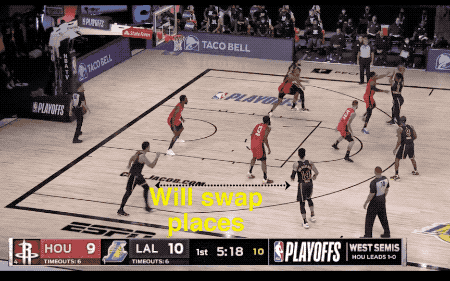
By taking a page from the KD-era Warriors, the Lakers created a simple hierarchy that enhances everyone. The two stars are the surveyors and everyone else is a mover. (Davis and James have the two slowest average speeds on the team, and almost everyone else moves faster than four miles an hour. Dwight Howard’s at 3.98 MPH, and Dion Waiters was at 3.87 MPH in his limited minutes). The surveyors set up the movers, and the movers keep attention away from the surveyors. That’s exactly how the Warriors retained a piece of Strength in Numbers even as their roster became more top-heavy.
So while the Lakers’ connection to the Warriors may not seem as obvious, it still exists. Without it, they’d be out of the bubble like the Clippers, who could never develop a cohesive system that retained the roster’s hierarchical structure.
Golden State’s story, of course, is not finished. Curry, Thompson, Green, and Kerr are coming back next year, and they’re more than capable of evolving their approach to fit with the times. It won’t be easy for them to stay one step ahead of a collection of contenders that continue to iterate on their principles, but we certainly shouldn’t count them out.
That’s a story for another day, though. Even if their dynasty can’t generate a second wind, these conference finals show how it has already turned the league into a more diverse place.


